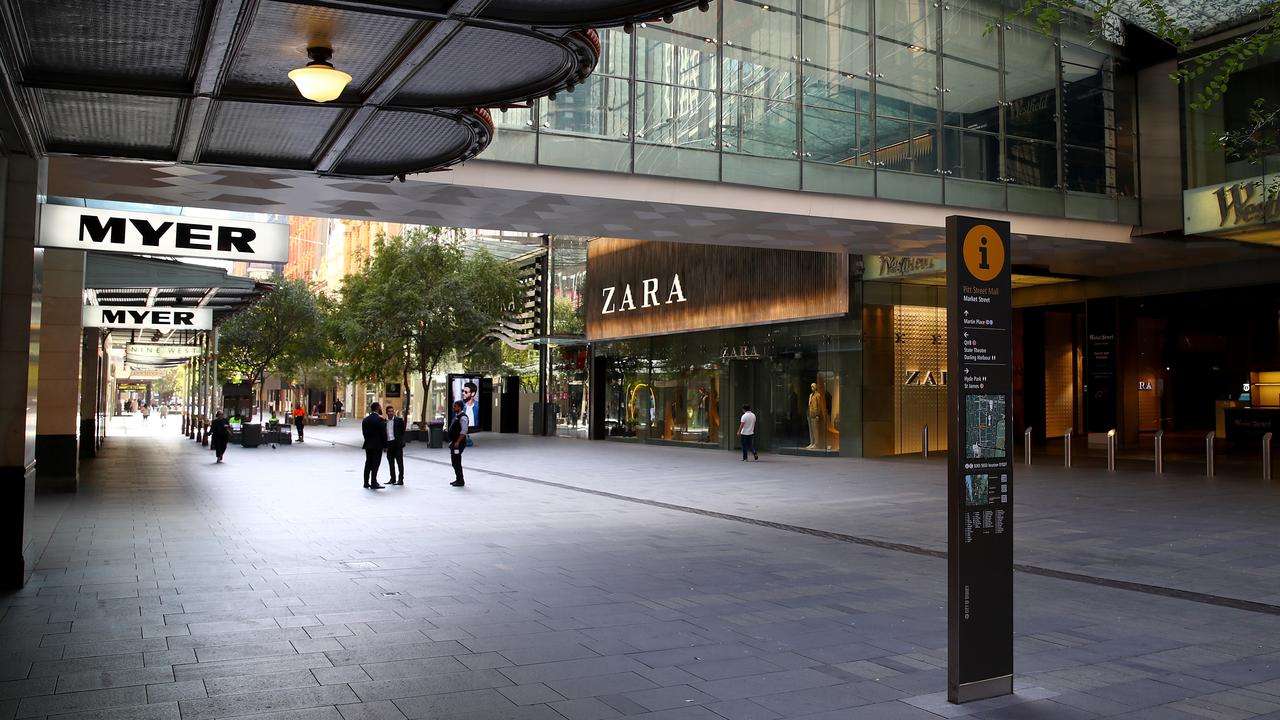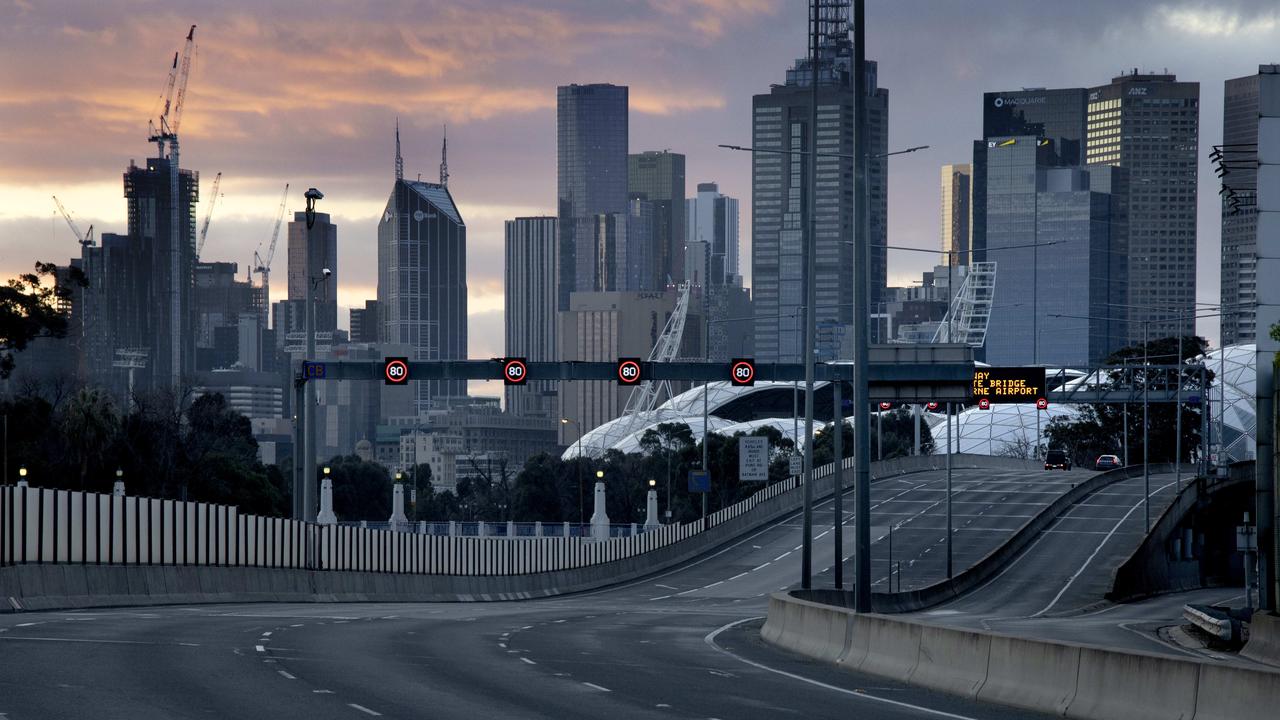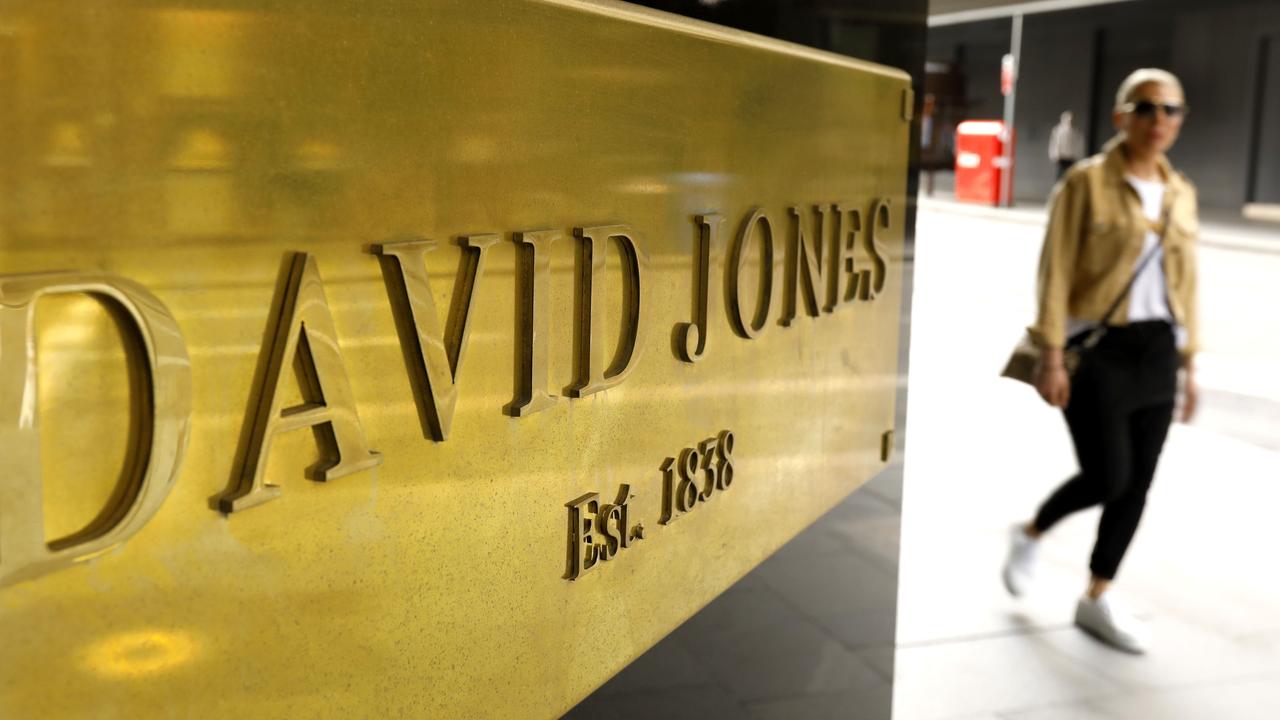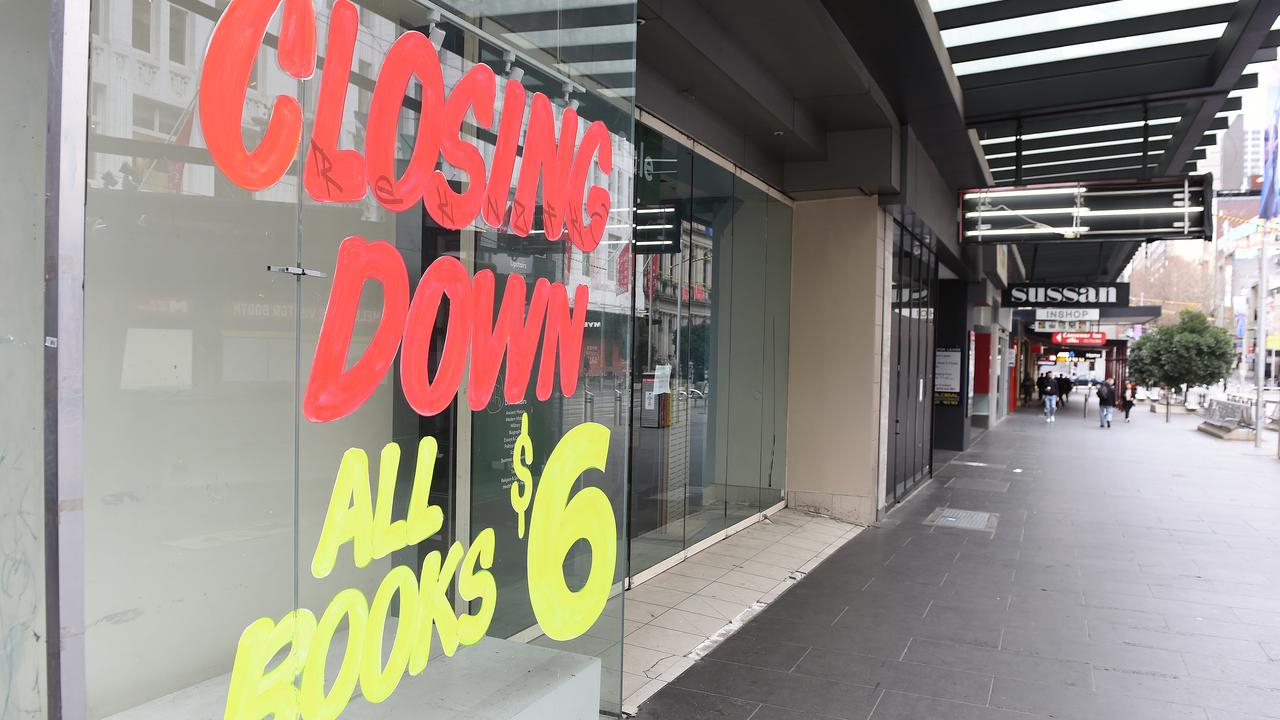Coronavirus could permanently change Australia’s CBDs
Experts fear the look and feel of our major capitals will rapidly deteriorate, thanks to a permanent “mass exodus” of workers and shoppers.
A huge Lego rendition of Darth Vader looms over the toy floor of Myer’s flagship Sydney CBD store, its light sabre glowing red; but there are few wide-eyed fans to notice.
No one is paying attention to a huge video screen showing a dad and daughter extolling the educational benefits of playing with Barbie dolls in a riotously pink corner of the department store.
Across the road, David Jones has just spent $200 million on a top-to-toe rebirth of its store which reopened slap-bang in the middle of a pandemic. It sparkles and shimmers, but one of the few customers on the menswear floor is browsing, not buying. She’s only come into the CBD because of a dental appointment
“I feel so sorry for them. Look what they’ve done to the place, it’s so bright and light, but who is shopping in the city at the moment?” she tells news.com.au.
Businesses of all stripes are crossing their fingers that when restrictions ease, customers will return. Indeed, many suburban areas are already showing signs of an uptick.
But in Australia’s CBDs it’s a different story and there are increasing concerns that they won’t bounce back when COVID-19 is done. An economic downward spiral could lead to a worst-case scenario reminiscent of many US cities where barren CBDs are surrounded by more lively suburbs.
An urban planner told news.com.au there was “mass exodus” from CBDs, potentially leading to a “dark prognosis” for their future. If businesses go, the retailers will follow, and the residents after that.
RELATED: Follow our live coronavirus coverage

MYER’S DARK WARNING ABOUT CBDS
Myer was the latest to ring the warning bell. Last week, it said that since it reopened its stores, sales in its CBD branches – excluding Victoria – were down 33 per cent on last year. Sales in its suburban and regional stores had fallen too, but by just 9 per cent.
“There has been an unprecedented drop in traffic in CBDs and that’s likely to remain for some time,” said chief executive officer John King.
“So long as we don’t have workers and tourists, these stores will remain significant areas of concern. We believe there has been a permanent change to the CBD landscape and a high percentage of people will continue to work from home and the proportion we saw previously will not come back.”
City of Sydney council estimates that before the pandemic, 615,000 people streamed into the CBD to shop, work, eat or play every day. The few square kilometres from Central station to the harbour were responsible for 7 per cent of Australia’s total economic activity.
Melbourne’s CBD was not far behind. Individually, the centres of Sydney and Melbourne have a gross domestic product bigger the entirety of Tasmania, the Northern Territory and the ACT.

Griffith University urban and environmental planner Dr Tony Matthews told news.com.au that while the full data was not yet in, there was increasing evidence of a “mass exodus” from CBDs with many workers reluctant to return.
“CBDs have a workforce mostly in professional services or their supporting industries such as restaurants and coffee shops. If you don’t have those base tenants in, you also don’t have a large proportion for you customer base for those restaurants, cafes and indeed Myer.
“Department stores are bloody big shops and they’re not cheap,” he said.
RELATED: Kmart boss hits out at Melbourne restrictions

NO LONGER VIABLE TO STAY IN CBD
“A large part of why retailers have CBD stores is as a symbolic flagship. Often it’s not the best performing shop, but CBDs are the jewel of retail space. However, if they are no longer the focal point then there will come a time that it will be no longer viable to remain in a situation like that.”
Dr Matthews said it was the same for large office buildings that may slowly find tenants drifting away as leases end or downsizing for a COVID-normal future.
US online giant Pinterest has just paid $US86 million ($A118 million) to terminate its upcoming lease on a downtown San Francisco building that would have served as an extension to its current CBD headquarters.
Working from home meant it no longer needed the extra space.
In Australia, there are reports of some major companies in CBDs already scaling back office space by around 20 per cent in some cases.
“It’s a dark prognosis but what we’ve learned though the pandemic is that a decentralised workforce can still be productive and you may not need to spend large amounts on property,” Dr Matthews said.
“Businesses won’t stay in CBDs unless it makes economic sense too. The trend seems to be away from CBD office space.”
RELATED: Move by insurers an ‘ominous’ sign of Myer and David Jones’ financial health

PEOPLE STAYING AWAY
Data from research firm Roy Morgan and Uber showed that in July, Sydney’s CBD had half the people travelling within it compared to February. Even in Perth, which has seen relatively few COVID-19 cases, CBD foot fall is only at 75 per cent normal levels.
“Perth has not had any restrictions for a long time so to see numbers still down suggests businesses are now used to having people at home,” said QUT retail expert Professor Gary Mortimer,
“In Brisbane, George Street is dead. Lots of people that would have been wandering around at lunchtime and between meetings aren’t there and that high foot fall was vital to businesses and retailers.”
Prof Mortimer said it was unlikely CBDs would become retail ghost towns. But there would be a contraction, he said. If there were several shopping centres or strips in a city centre, COVID may lead to one falling by the wayside.
Department stores are in a tricker position; they may want to reduce their rent by shedding a few floors of their flagship stores – but who will want to take up the space?
Both Melbourne and Sydney are trying hard to ensure the worst predictions don’t eventuate.
The Victorian Government has announced a $290 million package to inject life back into the CBD including grants to help restaurants set up tables, outdoor seating and umbrellas on streets closed to traffic.
The NSW Government is looking bring more night-life to the city and surrounding suburbs that have been hit not just by lockdowns but by the controversial pre-pandemic lockout laws as well.

RESIDENTS COULD LEAVE TOO
A vaccine and swift reopening of tourism and overseas students might give CBDs more of a boost, said Prof Mortimer.
If firms do move out, empty offices could be retrofitted into apartments. The centres of Sydney, Melbourne and Adelaide all have north of 15,000 residents – and often many more in surrounding suburbs – that should provide some cushion if workers and tourists are absent.
But Griffiths’ Dr Matthews said if offices shut, many of the CBD residents who worked in them and valued having a short commute might up sticks too.
“It doesn’t matter how nice your city apartment is, it’s not the same as having outdoor space.”

VICIOUS CYCLE FOR CBDS
Fewer residents, shops and business will mean less rates and taxes flowing into local government which in turn could lead to a vicious cycle of less spending in CBDs in turn deterring people from visiting.
However, Sydney CBD wouldn’t end up as Detroit, Dr Matthews said, a city known globally for urban blight and a struggling council which at one point went bankrupt.
Detroit was a city that was dependent on one major industry – car manufacturing. Sydney and Melbourne CBDs have many industries including finance, real estate and government, so were more resilient.
“But there will be a period of profound adjustment for our cities that may result in fluctuating urban populations and questions about what you do with certain buildings and areas,” he said.
“It sounds depressing but at the moment we don’t know what the upsides will be post-pandemic. You always see the bad news before you see the good news.”
The good news for CBDs will be if the likes of Myer and David Jones are still there a year or two from now.




